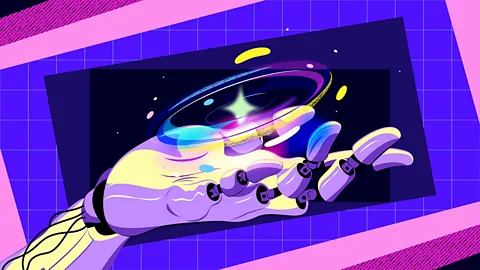
Will AI algorithms and robots spell the end of human creativity and artistry, or can they be harnessed to augment our own creative potential?
When Marcel Duchamp proposed that a porcelain urinal be considered art and submitted it for exhibition in early 20th-Century New York, he flipped the art world on its head. He argued that anything could be considered as art, if chosen by the artist and labelled as such. It was a profoundly revolutionary thought which challenged previous notions of art as beautiful, technically skilful and emotive.
In much the same way, AI-created artworks are disrupting the accepted norms of the art world. As philosopher Alice Helliwell from Northeastern University London argues, if we can consider radical and divergent pieces like Duchamp’s urinal as art proper, how can something created by a generative algorithm be dismissed? After all, both were controversial at the time and contain objects that haven’t technically been created by an “artist’s” hand. “Historically, the way we understand the definition of art has shifted,” says Heliwell. “It is hard to see why a urinal can be art, but art made by a generative algorithm could not be.”
Throughout history, every radical artistic movement has been intimately connected to the cultural spirit of the era, a reflection of society’s preoccupations and concerns. AI is no different. But technological revolutions like artificial intelligence need not signify the “end of art” as many fear. Instead, they can help to kickstart an artistic transformation and move us towards totally different ways of seeing and creating, something Marcus du Sautoy, a scholar at the University of Oxford and author of The Creativity Code: Art and Innovation in the Age of AI, would contend. Humans are just as prone to behaving like machines, repeating old behaviours and getting bogged down with rules. “AI might help us to stop behaving like machines…and kick us into being creative again as humans,” says du Sautoy. He sees it as a powerful collaborator in the pursuit of human creativity.
There is historical precedence for new technology liberating us from our creative shackles. Take the invention of photography in the 1800s for example. Some artists saw the camera as the opposite of an artist, and photographs as the mortal enemy of the art establishment. But instead of replacing painting, photography became a driving force in the development of the experimental modern art movement of the 20th Century, as artists moved away from realism towards abstraction, a shift that paved the way for the contemporary art of today.
原创编写 版权所有 侵权必究! 每日更新 个性化阅读 英语飙升!
1.1.What was the impact of Marcel Duchamp’s urinal on the art world?
A It reinforced traditional art standards.
B It was considered beautiful and skillful.
C It revolutionized art perceptions.
D It diminished human creativity.
解析:选C。C 细节理解题。第二段指出,杜尚的小便器“颠覆了艺术界”(flipped the art world on its head),并“挑战了先前关于艺术是美丽、技术娴熟和情感化的观念”(challenged previous notions of art)。正确选项C(挑战了基本的艺术概念)是对这一核心影响的概括。A(强化了传统艺术标准)和B(被认为是美丽和娴熟的)与原文意思相反;D(削弱了人类创造力)在段落中未提及。故选C。
2.2.According to Alice Helliwell, why should AI-created art be considered art?
A It is technically skillful.
B It resembles traditional art.
C It is created by artists.
D Art definition has evolved.
解析:选D。D 推理判断题。第三段引用Helliwell的观点,强调“从历史上看,我们理解艺术定义的方式已经发生了变化”(Historically, the way we understand the definition of art has shifted),并以此作为类比,认为AI艺术不应被断然拒绝。正确选项D(艺术的定义并非一成不变)准确地捕捉了这一推理依据。A(技术娴熟)、B(类似传统艺术)、C(由艺术家制作)均非Helliwell论证的核心。故选D。
3.3.How does Marcus du Sautoy view the role of AI in creativity?
A It collaborates to enhance creativity.
B It hinders artistic innovation.
C It makes humans more machine-like.
D It imposes rigid creative rules.
解析:选A。A 推理判断题。第四段中,Marcus du Sautoy提出,AI可以帮助人类停止像机器一样行为,并“促使我们重新变得有创造力”(kick us into being creative again),他将AI视为“人类追求创造力过程中的强大合作者”(a powerful collaborator)。正确选项A(通过协作来增强创造力)是对他观点的直接推断和同义转述。B(阻碍艺术创新)、C(使人类更像机器)、D(强加严格的创作规则)都与他的积极看法相悖。故选A。
4.4.What was the effect of photography on painting in the 19th century?
A It replaced painting entirely.
B It led to abstract art.
C It was opposed by many artists.
D It made art more realistic.
解析:选B。B细节理解题。最后一段明确指出,摄影没有取代绘画,而是成为了“20世纪实验性现代艺术运动发展的催化剂”(catalyst in the development of the experimental modern art movement),促使艺术家从现实主义转向抽象主义(artists moved away from realism towards abstraction)。正确选项B(催生了向抽象艺术的转变)对应了这一具体细节。A(使绘画完全过时了)与原文“instead of replacing painting”直接矛盾;C(遭到许多艺术家反对)虽然是事实,但并非摄影对绘画产生的最终影响;D(强化了写实风格)与原文所述的转向抽象背道而驰。故选B。
5.5.Which title best summarizes the passage?
A The Creative Partnership: AI and Art
B How AI is Redefining Art
C Art, Society, and Technology
D The End of Human Artistry
解析:选A。A 主旨大意题。标题需抓住文章核心——“合作”而非“替代”。A选项中的“Creative Partnership”精准体现了AI作为合作者(collaborator)的角色。B和C选项仅是文章涉及的方面,不够全面;D选项是文中批驳的观点,并非主旨。故选A。
